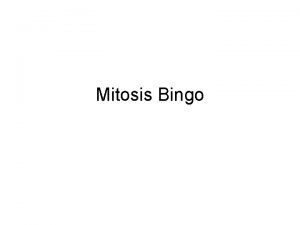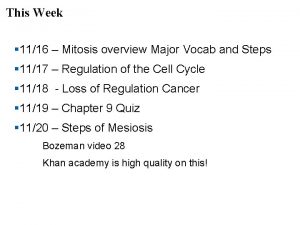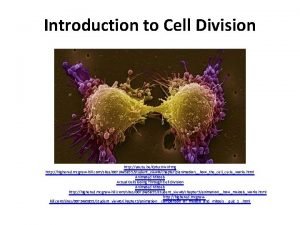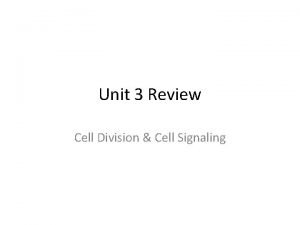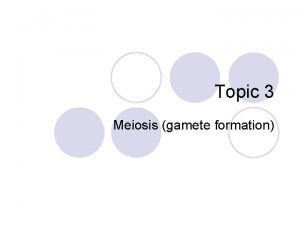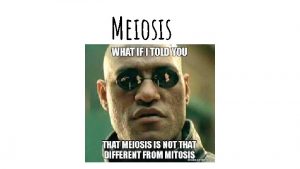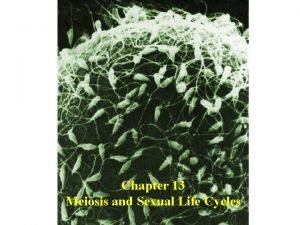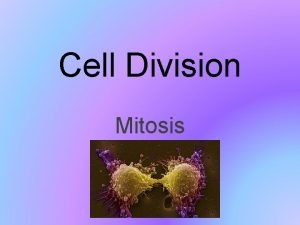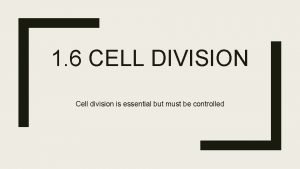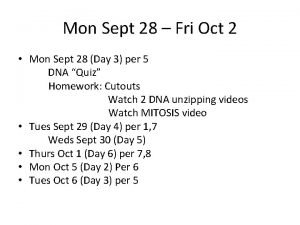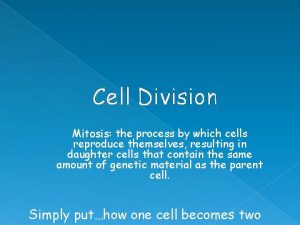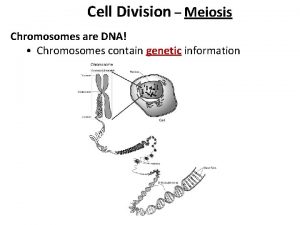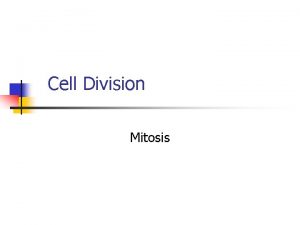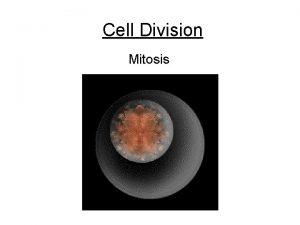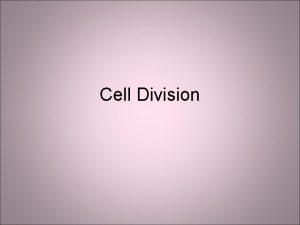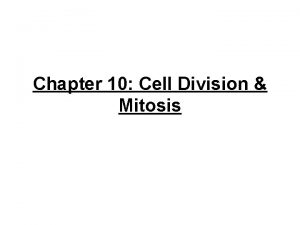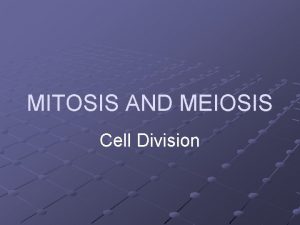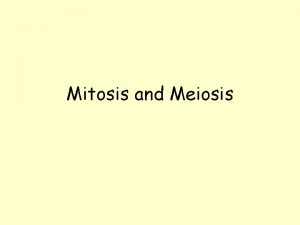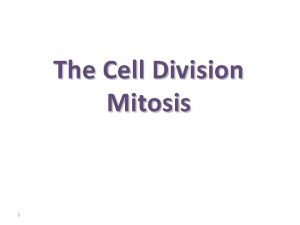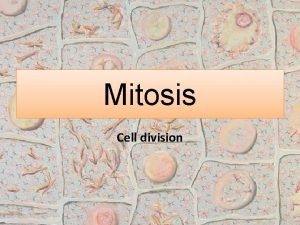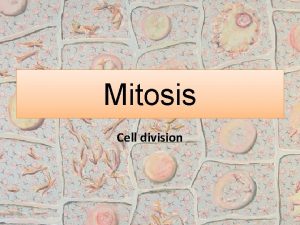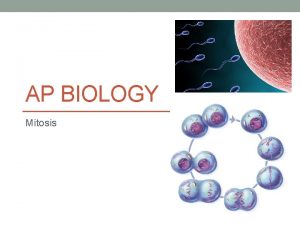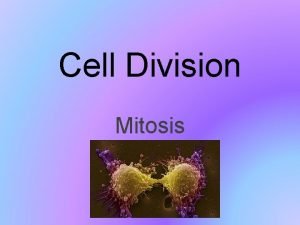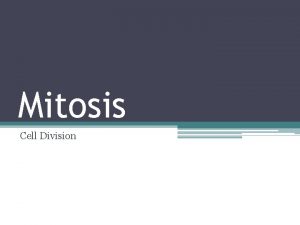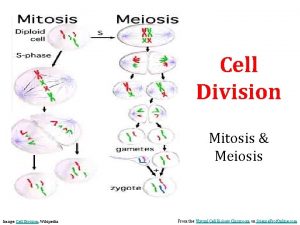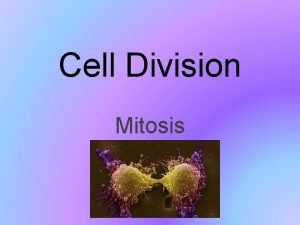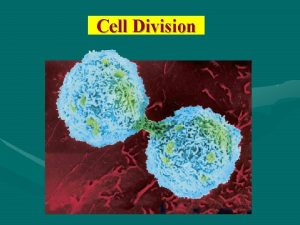Mitosis Cell division cell production What kind of























- Slides: 23

Mitosis �Cell division/ cell production �What kind of cells? �Nerve, skin, etc. - somatic �Same / all the time �Mitosis is reproduction in which cells produce identical replicas

Mitosis Number of divisions Number of daughter cells Daughter cells genetically identical to parents? Chromosome # different or same as parent? What type of cells do this? When in life does this happen? What role do these cells play? Meiosis

Mitosis Meiosis Number of divisions 1 2 Number of daughter cells 2 4 Daughter cells genetically identical to parents? Yes No Chromosome # different or same as parent? Same as parent Half of parent Somatic cells Sex cells When in life does this happen? Throughout life At sexual maturity What role do these cells play? Growth and repair Sexual reproduction What type of cells do this?


Meiosis �Meiosis occurs in sexual reproduction when a diploid germ cell produces four haploid daughter cells that can mature to become gametes (sperm or egg).

Meiosis �The genetic code of a human contains 46 chromosomes �Half of this number is in egg and sperm �Divided twice which turns out 4 cells (gametes) �Each of these will have only half of the number of chromosomes; but each will contain genetic info from each parent

Mitosis Meiosis Number of divisions 1 2 Number of daughter cells 2 4 Yes No Same as parent Half of parent Where Somatic cells Sex cells When Throughout life At sexual maturity Role Growth and repair Sexual reproduction Genetically identical? Chromosome #


What Meiosis is About Meiosis allows the creation of unique individuals through sexual reproduction.

Summary of Meiosis � 2 cell divisions �Starts with 2 copies of each chromosome ( homologues), each with 2 chromatids �In meiosis I, crossing over in prophase I mixes alleles between homologues �In metaphase I, homologous chromosomes pair up and in anaphase the homologous chromosomes separate to be in two cells �Meiosis II - second division occurs. The end result is 4 gamete cells with ½ the original # of chromosomes ( haploid)


�https: //www. youtube. com/watch? v=v. A 8 a. Mp. Hw. Yh 0& feature=related

Interphase I � Cells undergo a round of DNA replication forming duplicate chromosomes �Each chromosome has two sister chromatids held together by a centromere

Prophase I �Chromosomes coil up and spindle forms �Each chromosome pairs with its corresponding homologous chromosome to form a tetrad �Crossing over may occur when chromatids exchange genetic material �Crossing over results in new combinations of alleles on a chromosome

Crossing Over

Metaphase I � The centromere of each chromosome becomes attached to a spindle fiber �Spindle fibers pull the tetrads to the equator of the spindle �Homologous chromosomes are lined up side by side as tetrads

Anaphase I �The fibers pull the homologous chromosomes toward opposite end of the cell �Centromeres do not split �This ensures that each new cell will receive only one chromosome from each homologous pair

Telophase I �The spindle breaks down and the chromosomes uncoil �The cytoplasm divides to yield two new cells �Each cell has half the genetic info of the original cell because it has only one homologous chromosome from each pair

Prophase II � Meiosis I results in two haploid (N) daughter cells, with half the number of chromosomes as the original cell �A spindle forms in each of the two new cells and the fibers attach to the chromosomes

Metaphase II � The chromosomes line up in a similar way to the metaphase stage of mitosis �The chromosomes are pulled to the center of the cell and line up randomly at the equator

Anaphase II �The centromere of each chromosome splits �The sister chromatids separate and move toward opposite ends of the cells

Telophase II �Nuclei re-form �The spindles breakdown �The cytoplasm divides

Meiosis II �Meiosis II results in four haploid (N) daughter cells. �Each haploid cell contains one chromosome from each homologous pair �Haploid cells will become gametes transmitting genes to off spring
 Pre dan post production adalah
Pre dan post production adalah Mitosis and meiosis
Mitosis and meiosis Two cells are produced
Two cells are produced Mitosis bingo
Mitosis bingo Bioflix activity: mitosis -- events of mitosis
Bioflix activity: mitosis -- events of mitosis Youtu.beq
Youtu.beq Section 10-2 cell division
Section 10-2 cell division Cell cycle and cell division
Cell cycle and cell division Phases of cell cycle
Phases of cell cycle Significance mitosis
Significance mitosis Mitosis division
Mitosis division Chromosomes human
Chromosomes human Mitosis division
Mitosis division Human development cycle
Human development cycle Ipmat mitosis
Ipmat mitosis Aster cell division
Aster cell division Mitosis division
Mitosis division Short division vs long division
Short division vs long division Example of synthetic division
Example of synthetic division Division is the short form of repeated
Division is the short form of repeated Synthetic devision
Synthetic devision Anaphase
Anaphase Number of divisions in mitosis
Number of divisions in mitosis Number of chromosomes in meiosis
Number of chromosomes in meiosis



